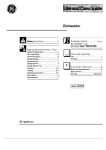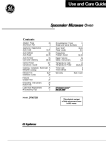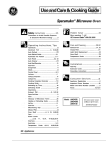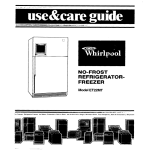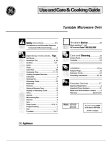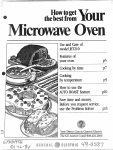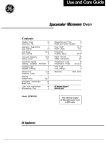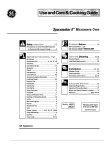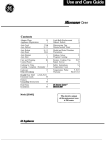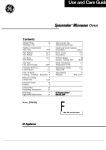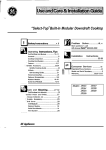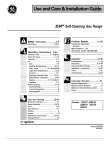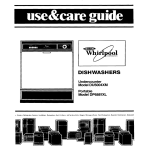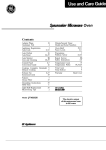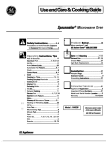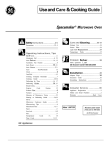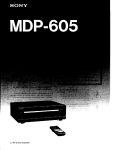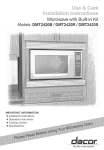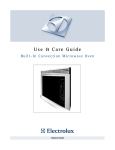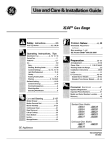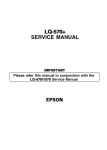Download GE Spacemaker JVM240 User's Manual
Transcript
I Useand~re&boMng Guide \
SpacemakeP Microwave Oven
Safe~ instructions ....................3-5
Problem Solver...............................33
Precautions to Avoid Possible Exposure
More questions ?...call
GE Answer Cente~ 800.626.2000
to Excessive Microwave Energy .............2
Operating Instrutiions, nps
Care and Cleaning ...................29-32
Add 30 Seconds . . . . . . . . . . . . . . . . . . . . . . . . . . . . . . . . . . . . . . . . . . 13
Aluminum Foil ...........................4, 21,24,26
Auto Defrost..................................................2O
Auto Defrost Guide......................................21
Automatic Fan ...........................................5, 7
Auto Roast..............................................22,23
Auto Simmer .................................................23
Clock. . . . . . . . . . . . . . . . . . . . . . . . . . . . . . . . . . . . . . . . . . . . . . . . . . . . . . . . . . . . . . . . . . 8
Exhaust Fan............................................3
1,32
Grease Filter ..................................................3
1
Light Bulb Replacement.............................3O
Oven Shelf .....................................................29
Temperature Probe .....................................29
Control Panel...............................................8,9
Cook . . . . . . . . . . . . . . . . . . . . . . . . . . . . . . . . . . . . . . . . . . . . . . . . . . . . . . . . . . . . . . . 17
Cooking by Temperature ...........................1 9
Cooking by Time. . . . . . . . . . . . . . . . . . . . . . . . . . . . . . . . . . . 12, 13
Cooking Complete Reminder ...................10
Cooking Guide.. ............................................27
Defrosting by Time. . . . . . . . . . . . . . . . . . . . . . . . . . . . . . . . . . . . . . 18
DefrostingGuide..........................................26
Delayed Cooking . . . . . . . . . . . . . . . . . . . . . . . . . . . . . . . . . . . . . . . . . . 11
Delay Start/Reminder . . . . . . . . . . . . . . . . . . . . . . . . . . . . . . . . 13
Exhaust Fan ..................................5, 9,31,32
Express Cook . . . . . . . . . . . . . . . . . . . . . . . . . . . . . . . . . . . . . . . . . . . . . . . . 13
Features . . . . . . . . . . . . . . . . . . . . . . . . . . . . . . . . . . . . . . . . . . . . . . . . . . . . . . . . . . 10
Glossary of Microwave Terms ..................24
Heating or Reheating Guide......................25
Hold Time. . . . . . . . . . . . . . . . . . . . . . . . . . . . . . . . . . . . . . . . . . . . . . . . . . . . . . . 11
Kitchen Timer . . . . . . . . . . . . . . . . . . . . . . . . . . . . . . . . . . . . . . . . . . . . . . . . 11
Microwaving Tips...........................................6
Minute Pad .......................................................8
Oven Shelf ......................4, 5, 10, 14,28,29
Popcorn . . . . . . . . . . . . . . . . . . . . . . . . . . . . . . . . . . . . . . . . . . . . . . . . . . . . . . . . . . 14
Power Levels
.......2,7,8,11,
12,14,
17-20,22,25-27
Reheat . . . . . . . . . . . . . . . . . . . . . . . . . . . . . . . . . . . . . . . . . . . . . . . . . . . . . . . . . . . . . 16
Snacks . . . . . . . . . . . . . . . . . . . . . . . . . . . . . . . . . . . . . . . . . . . . . . . . . . . . . 14, 15
Sound Level Feature . . . . . . . . . . . . . . . . . . . . . . . . . . . . . . . . . . . 13
Temperature Probe 4,8-11, 19,22,23,29
GE Appliances
lnstallation..........................................32
Adapter Plugs . . . . . . . . . . . . . . . . . . . . . . . . . . . . . . . . . . . . . . . . . . . . . . 32
Extension Cords ...........................................32
Groundinginstructions...............................32
Consumer Services ...................35
ApplianceRegistration..................................2
Important Phone Numbers........................35
Model and Serial Number Location ...........2
Warranty ........................................BackCover
Modek. NM240
Miuowavepowerotipti
of tikoven h 850 Wn
JVM241
I
4
I
~LP US ~LP
YOU...
Before using your oven,
read this guide carefully.
Be sure your microwave
oven is registered.
It is intended to help you operate
and maintain your new microwave
oven properly.
Keep it handy for answers to your
questions.
If you don’t understand something
or need more help, all:
GE Answer Center
800.626.2000
24 hours a day
7 days a week
It is impofiant that we know
the location of your microwave
oven should a need occur for
adjustments.
Your supplier is responsible for
registering you as the owner.
Please check with your supplier
to be sure he has done so; also
send in your Consumer Product
Ownership Registration &d.
If you move, or if you are not
the origiti purchaser, please
write to us, stating model and
serial numbers.
~ apptiance must be registered.
Please be certain that it is.
Write to:
GE Appliances
Range Product Service
Appliance Park
Louisville, KY 40225
Write down the model and
serial numbers.
You’ll find them on a label inside
the oven.
~ese numbem are dso on the
Consumer Product Ownership
Registration Card that came with
your microwave oven. Before
sending in this car~ please write
these numbers here:
Model Number
Serial Number
If you received a
damaged oven...
Immediately contact the derder
(or builder) that sold you the oven.
Save time and money.
Before you request service...
Check the Problem Solver in the
back of this guide. It lists causes of
minor operating problems that you
can correct yourself.
Ml these things are normal
with your microwave oven.
Steam or vapor escaping from
around the door.
● Light reflection around door or
outer case.
● Dimming oven light and change
in blower sound may occur while
operating at power levels other
than high.
● Dull thumping sound while oven
is operating.
● Some W-Radio interference
might be noticed while using
your microwave oven. It’s
similar to the interference
aused by other small
appliances and does not
indicate a problem with
your oven.
●
Use these numbers in any
correspondence or service calls
concerning your microwave oven.
PmCA~ONS TO AVOD POSS~M EXPOSTO EXCESS~ M~OWA~ ENERGY
(a) Do Not Attempt to operate this oven with
the door open sinm open~oor operation can
resdt in _ exposwe to microwave
energy. It is important not to defeat or tamper
with the safety interlocks.
~) Do Not Phce any object between the oven
front face and the door or Wow sod or cleaner
residue to accmdate on sealing stiams.
2
(c) Do Not-rate the oven ifit is damagd It is
partidarly important tit tie oven door close
properly and tit there is no damage to the:
(1) door @nt)
(2) hinges and latches @roken or loosened)
(3) doorse~ andseding s~am.
(d) me&en Shodd Not be adjwtedor repaired
by anyone except properly qdified servim
personnel.
-
,,, -
Men using electrical applianms, basic safety
precautions shodd be followed, including the
fouowing:
●
●
A W~NG-~ored.mtieriskof
●
●
●
●
,—
●
Do not mount this app~ce over a SW=
or locati this app~ce ody m accordance with
the provided -tin -ctions.
. Do not cover or bM any openings on the
appWnee.
Do not store this apphce outdoors. Do not
use this product near water-for example, in a wet
basemen~ near a swimrning pool or near a sti
This microwave oven is not approved or tested
for marine W
Do not store anything directiy on top of the
-wave oven sfice when the oven is in
operation.
Do not immerse power cord or plug in water.
Keep power cord away from heated surfaces.
●
●
●
●
●
/
bums, electric shock fire, injury to persons
or exposure to excessive microwave energy:
Read and fo~ow the specific ‘tPremutions to
Avoid Possible ~sure to Excessive Mcrowave
Energy” on the previous page.
W apphce must be grounded. ~Mect
ody to properly grounded outiet See &ounding
Mtructions section in the back of this guide.
Use this app~ce ody for its intended use as
described in this guide. Do not use corrosive
chernicds or vapors in this apphance. This
microwave oven is specifidly designed to heat
or cook f- and is not intended for laboratory
or indusW use.
This over-tie-range oven was designed
for w over ranges no wider than O inches.
It maybe instied over both gas and elwtric
cooking quipment.
For best operation, plug this appbce into its
own electrid outie~ to prevent fickering of
~~ blowing of be or tripping of circuit
breaker.
●
●
●
●
Do not let power cord hangover edge of table
or counter.
Do not operate this appkce ifit has a
damaged power cord or plug ifit is not
working propetiy, or if it has been damaged
or dropped.
See door surface cleaning instructions in the Gre
and ~eaning swtion(s) of your guide.
This app~nce should be serviced only by
q-cd service personnel. Contact nearest
authotied service facfiity for examination,
repti or adjustment.
A with any appMnce, close supervision is
necessary when used by ctidren.
To reduce the risk of fi in the oven cavity:
—Do not overcook food. Wefily attend
applian~ if paper, plastic or other combustible
materiti are placed inside the oven to factiitate
cooking.
—Remove wire twist-ties and meti han~es
from paper or pktic containers before
pbcing them in the oven.
—Do not use your microwave oven to dry
newspapers.
—Do not use recycled paper products. Recycled
paper towe@ napkins and waxed paper can
contain meti flecks which may cause arcing
or igni~ Paper products containing nyIon or
nylon -ents shodd be avoided, as tiey
may *O ignite.
—Do not pop popcorn m your microwave oven
dess in a special microwave popcorn amssory
or urdess you use popcorn labeled for use in
microwave ovens.
—Do not overcook potatoes. ~ey could
dehydrate and catch fire, causing damage
to your oven.
—Do not operate the oven w~e empty to avoid
damage to the oven and the danger of b. H
by accident the oven shodd run empty a minute
or two, no harm is done. However, try to avoid
operating the oven empty at au tire-it saves
energy and prolongs the life of the oven.
●
(co-d-page)
3
WORW SMEW mS~UC~ONS
(mnthued)
—Do not use the oven for storage purposes.
Do not leave paper products, cooking utensih
or food in the oven when not in use.
—If materiah inside oven should igni@ keep
oven door closed turn oven off, and disconnect
power cord, or shut off power at the fuse or
circuit breaker panel.
Some products such as whole eggs and sealed
containe%for example, closed jars-w~
explode and shodd not be heated in this
microwave oven. Such use of the microwave
oven codd resuk in injury.
Avoid heating baby food in glass jars, even with
the lid off. Make sure dl infant food is thoro@y
cooked. Stir food to distribute the heat evedy.
Be care~ to prevent sdding when warming
formda or breast mfr. The container may feeI
cooler than the mW rea~y is. ~ways test the
fibefore feeding the baby.
. Don’t defrost frozen beverages in narrow
nwked botdes (especially carbonated beverages).
Even if the container is open~ pressure can bufld
up. This can cause the container to burst possibly
resuking in injury.
Use fofl ody as directed in this guide. W
dinners may be rnicrowavd in fofi trays less than
3/4” him remove the top fofi cover and return the
tray to the box. men using fod inthe microwave
eve% keep thefoti (other than rnetishem at
W 1 k~ away tim the sides of the oven.
Cootiare may beco&e hot because
of heat transferred from the htited
fti Potholders maybe needed to
han~e the cookware.
Foods cooked & ~uids (such as pasta) may tend
toboti over more rapi~y than foods containing
less moisture. Shotid this occur, refer to the k
and ~eaning section(s) for ‘instructions on how to
clean the inside of the ovem
●
●
●
●
●
●
. men cooking por~ fo~ow the dirwtions
exactly and always cook the mwt to an internal
temperature of at least 170°F. This assures tha~
in the remote possibility that trichina maybe
present in the mea~ it WW be ~led and meat
WW be safe to cab
Do not boti eggs in a microwave oven.
~e~~e ww bufid up inside egg yO& Md ~
cause it to burs~ possibly rwuking in injury.
Foods with unbroken outer ‘skinW ~•
- such &potatoes, sausag~, tomatoes,
apples, chicken livers and other
giblets, and,egg yoh (see previous
caution) shoddbepiercedto Wow
steam to escape during am. ‘.
●
●
●
●
●
●
Thermometer-Do not use a thermometer in
food you are microwaving tiess the thermometer
is designed or recommended for use in the
microwave oven.
4.
Remove the temperature probe from the oven
when not using it to cook with. E you leave the
probe inside the oven without inserting it in food
or fiqui~ and turn on microwave energy, it can
create electrical arcing in the oven and damage
oven w*.
Plastic cookwabPlastic cookware designed
for microwave coohg is very use~, but should
be used caretily. Even microwave-safe plastic
may not be as tolerant of overmoking renditions
as are @ass or ceramic materials and may
soften or char if subjected to short periods of
overcooking. k longer exposures to overcooking,
the food and cookware codd ignite. For these
reasons: 1) Use microwave-safe plastics ody and
use them in strict complian~ with the cookware
manufacturer’s recommendations. 2) Do not
subject empty cookware to microwaving.
3) Do not permit c~dren to use plastic
cookware without complete supervision
,’
Not aM p=c wrap is suitable for use in
microwave ovens. ~eck the package for
proper use.
Spontaneous bofi&Under certain special
circnmstanx, liquids may start to boil during or
shordy after removal horn the microwave oven
To prevent burns from splashing Iiqui& allow the
container to stand in the oven for 30 to ~ sewn~ ._
after the oven has shut o~
—
.—
. i~~~ble~’ coowg pouches and ~tfy dosed
p~tic bags shotid be sli; pier~ or vented
as directed by package. Kthey are not plastic
cotid burst during or immediately after cooting,
possibly resdting in injury. Mso, plastic storage
containers shodd be at least partitiy uncovered
because they form a tight seal. men cooking
with containers tightly covered with plastic wrap,
remove wvering carefdly and direct steam away
from hands and face.
Hot foods and steam - cause
.~
. . . -b-. Be care~ when opening
*
any mntainers of hot f@ including
popcorn bags, cooking pouches and
boxes. To prevent possible injury,
direct steam away from hands
and face.
.,
●
Use of the sheMaccessory.
—Remove the shelf from oven when not in use.
—Do not store or mk with shelf on floor of oven.
Product damage may resti~
—Use pot holders when handing the she~and
cookware. They may be hot.
—Do not use microwave browning dish on shelf.
The she~cotid overheat.
—Use the shetiordy when cooking on 2 leveh.
—Be sure that the she~ is positioned properly
inside the oven to prevent product damage.
Do NOT USC the metal sheti with the Popcorn
program (see the Popcorn section).
●
he Efiaust H@
. Have it Wed =d properly grounded by a
qtied We~ See the special _tion
boo~et pa= with the microwave oven.
,-.
The e~aust fan in the oven W operate
automatica~y under certain conditions
(see Automatic Fan Feature). We the fan
is operating, caution is required to prevent
the starting and spreading of accidental
cootig fires wtie the exhamt fan is in
use. For this reason:
—Never leave surface units unattended at high
heat settings. Boilovers cause smoking and
greasy sp~overs that may ignite and spread if
exhaust fan is operating. To minirnke automatic
fan operation, use adequate stidcoobare and
use high heat otiy when necessary.
—k the event of a grease ~
smother flaming pan on surface
e unit by covering pan completely
with weti-fitting tit cookie sheet
or flat tray.
<lean the vent hood often. Do not a~ow grease
to btid up on the hood or the falter.
—Use care when cleaning the vent hood ~ter.
Grrosive cleaning agents, such as Iye-basti
oven cleaners, may damage the falter.
—men -g foods are under the h@
turn the fan o~ me fa~ if operating, may
spread the flame.
●
Optional Accessories
Avaflable at e~a cost fiorn your GE supplier.
W41 FMer Panel Et (for models ~BV
and W41B~.
MO GM tiOpy ~
~8~ CharCod Ffiter Kt for non-vented
instigation.
~s microwave oven is UL listed for
insta~ation over electric and gas ranges.
5
IF
YOU
To obtain service, see the Consumer Services page in
the back of this guide.
We’re proud of our service and want you to be
pleased. If for some reason you are not happy with the
service you receive, here are 3 steps to follow for
further help.
FIRST, contact the people who serviwd your
appliance. Explain why you are not pleased. In most
roes, this will solve the problem.
NEED
SERVICE...
NEXT, if you are still not please~ write all the
detailfiincluding your phone number—to:
Manager, Consumer Relations
GE Appliances
Appliance Park
buisville, KY 40225
FINALLY, if your problem is still not resolved, write:
Major Appliance Consumer
Action Panel
20 North Wacker Drive
Chicago, IL 60606
MICROWA~G mS
Make sure all cookware used in your microwave
oven is suitible for microwaving. Most glass
casseroles, cooking dishes, measuring cups, custard
CUDS , pottew or china dinnerware which does not
ha;e’rnetil;c trim or gl=e with a metallic sheen
can be used. Some mokware is labeled “suitable
for microwaving.”
● If you are not
sure if a dish is
microwave-safe,
use this test: Place
in the oven both
the dish you are
testing and a glass
measuring cup
filled with 1 cup of
water—set the measuring cup either in or next to the
dish. Microwave 1 minute at high. E the dish heats,
it should not be used for microwaving. If the dish
remains cool and ordy the water in the cup heats,
then the dish is microwave-safe.
●
6
Paper towels, waxed paper and plastic wrap
can be used to cover dishes in order to retain
moisture and prevent spattering. Be sure to vent
plastic wrap so steam can eswpe.
● Some microwaved foods require stirring, rotating
or rearranging. Check the Cooking Guide.
● Steam buflds up pressure in foods which are
tightiy covered by a skin or membrane. Pierce
potatoes, egg yolks and chicken livers to prevent
bursting.
●
If you use a meat thermometer whale cooking, make
sure it is safe for use in microwave ovens.
Variable power levels add flexibility to your
microwave rooking. The power levels on your
microwave oven can be compared to the surface units
on a range. High @ower ~vel 10) or full power is the
fastest way to cook and gives you 100% power. Each
power level gives you microwave energy a certain
percent of the time. Power Uvel 7 is microwave
energy 7070 of the time. Power bvel 3 is energy
30% of the time.
A high setting (10) will cook faster but may need
additional attention such as frequent stirring, rotating
or turning over. Most of your cooking will be done
on High (Power bvel 10). A lower setting will cook
more everdy and with less attention given to stirring
or rotating the food. Some foods may have better
flavor, texture or appearance if one of the lower
settings is used. You may wish to use a lower power
level when cooking foods that have a tendency to
boil over, such as scalloped potatoes.
Rest periods (when the microwave energy cycles o~
give time for the food to “equaltie” or transfer heat
to the inside of the food. An example of this is shown
with Power ~vel >the defrost cycle. If microwave
energy did not cycle off, the outside of the food would
cook before the inside was defrosted.
Here are some examples of uses for various
power levels:
~is microwave oven has an automatic fan feature to
protect it from too much heat rising from the cooktop
or range beneath it. It automatidly turns on at a low
speed if it senses too much heat.
If you have turned the fan on you may find that you
cannot turn it off. This is because the automatic fan
has come onto protect the internal parts of the
microwave.
~e fan will automatidly turn off when the intemrd
parts are cool. It may stay on for 30 minutes or more
after the range and microwave controls have been
turned off.
POWR LEVEL I BEST USES
High 10
Fish, baco~ vegetables,
boiling liquids.
Meal-High 7
Gende cooking of meat and
poultry; baking- casseroles
and reheating.
Medium 5
Slow cooking and tendefiing
such as stew~ and less tendercuts of meat.
hw 3
Defrosting without cooking;
simmering; delimte sauces.
Warml
Keeping food warm without
overcooking; softening butter.
I
I
7
u
,
YO~
TOUCH
COmOL P~L
The Touch Control Panel allows you to set the oven controls with
the touch of a finger. It’s desi~ed to be easy to use and understand.
1. DISPLAY. Displays time of day, time or
temperature during cooking functions, power level
being use~ cooking mode and instructions.
2. BEVERAGE. Touch this pad to heat or reheat a
beverage. No need to touch ST~T, the oven will
start immediately.
3. POPCORN. Touch this pad to mok prepackaged
microwave popeom weighing 3.0 to 3.5 ounces.
No need to touch STMT, the oven will start
immediately.
4. ~ME DEFROST. Gentle thawing at automatic
Power Level 3 (Low).
5. MICRO COOK Microwave for a selected
amount of time using automatic Power bvel
10 @i@).
6. AUTO DEFROST. Touch this pad and food
weight, then STMT. The oven automatidly
sets power levels and defrosting time.
7. E=RESS COOK Touch number pads 1 through
5 for 1 to 5 minutes of cooking. No need to touch
START, the oven will start immediately.
8. NUMBER PADS. Touch these pads to program
the miaowave.
9. POWER LEVEL. Touch this pad before entering
another power level number if you want to change
from automatic Power Level 10 @igh) for
cooking or Power bvel 3 @w) for defrosting.
10. CLOCK DISP~Y ON/OFF. Touch the O
number pad to turn the clock display on or off.
The Clock Display OflOff feature cannot be
used whfie a cooking feature is in use.
11. CLOCK Touch this pad to enter time of day
or check time of day while microwaving. To set
clock first touch CLOCK pad and then enter time
of day. For example, if time is 1:30, touch number
pads 1,3 and O and” 1:30” will appear in display.
Then touch START or CLOCK pad To reset or
change time, simply repeat above process.
12. SOUND LEVEL. Touch the SOUND LEVEL
pad. Touch number pad O, 1,2 or 3, then touch
ST~T pad to change the sound level of the
oven beeper.
13. ~TCHEN ~MER. This feature uses no
rniaowave energy. It fundions as either a kitchen
timer, as a holding period after defrost or as a
delay timer before time or temperature cooking.
8
14. REHEAT. Use Reheat for quick reheating of
a variety of foods using different times and
power levels.
15. COOK Touch this pa~ a code number and
weight of food for quick cooking of a variety of
foods using different times and power levels.
16. SNACKS. Touch this pa~ a code number and
weight or quantity of food to warm a variety of
snack foods.
17. AUTO ROAST. Insert probe. Touch this pa~
the desired number pad for the code, then START.
The oven slow-cook meat with the automatic
preset program.
18. TEMP COO~OLD. Use the temperature
probe to Wok by using a preset temperature. Once
food reaches preset temperature, oven switches to
HOLD setting and maintains that temperature
until you touch the CLwOFF pad.
19. DE~Y START~mNDER. A1OWS YOU to
program your oven to begin cooking at a preset
time of day-up to a 12-hour delay. The Reminder
fea~re m be used like an alarm clock.
20. ST~T. After dl selections are made, touch this
pad to start the oven.
21. ~. Use this with number pads to enter
whole minutes. For example, for 4 minutes touch
4 and MINUTE.
22. CLwOFF. men touche~ it shuk off the
oven and erases all settings (ex~pt time of day).
23. ADD 30 SEC. Press this pad for 30 seconds
of cook time, to add 30 seeonds to the cook
time as it’s counting down or for an “instant on”
for 30 sewnds.
24. VENT FAN. Press HI, LO or OFF for the
different fan speeds.
25. SURFACE LIGHT. Touch ON to turn on
the surface light. Touch NIGHT to turn on the
night light.
–
OPCORN
BEVEWGE
REHMT
=: ;;.~DEBE~DDo~R&
nn
nn
n Od
3
2
~PRESS COOK
MPRESSCOOK
4
WRESS WOK
5
EKPRESS WOK
8
d
J
POWER
LEVEL
o
m
DISPUYOWFF
4
6
n
9
n
I
MINUE
CLWR
~
I
I
r
1“
When You Plug in the Oven
The display panel displays “88888”, “18 POWR”
and d] of the oven functions. After 15 semnds, all
lights &sappear and “RESET” appears in the upper
portion. Touch the CLWOm pa4 set the clock
and oven is ready for use.
This wfll happen any time there is a power outage.
“PRObE” Appeam on tie Display:
● Probe has been forgotten when Auto Roast or
Temp Coo~old function is being used.
● Probe is not securely seated in oven wall receptacle.
9
?
f
TT,I
Ill
11/ ,
-
EEL -- ,
Il ——
H7---A “-i - ‘-” 1. Door Handle. Ptil to open door. Door must be
securely latched for oven to operate.
2. Door Latches.
3. Window with Metil Shield. Screen allows
cooking to be viewed while keeping microwaves
cotilned in oven.
4. Receptacle for Temperature Probe. Probe must
be securely inserted into receptacle before oven
will start any temperature or Auto Roast cooking.
5. Temperature Probe. Use with Temp CooWold
and Auto Roast functions ody.
6. Shelf. Lets you microwave several foods at once.
Food microwaves best when placed directiy on the
oven floor. Use this shelf ody when cooking foods
on two levels. (See Safety hstructions and Oven
Shelf section for special instructions.)
Coobng Complete Reminder
@or all cooking features except Temp Coo~old
and Auto Roast code 4)
To remind you that you have food in the oven, the
oven will display “End” and beep once a minute
until you either open the oven door or touch the
CLWOFF pad.
10
7. Touch Control Panel and Digitil Display.
For detailed information on each feature, see
Your Touch Control Panel section.
8. Hood Controls.
Vent Fan. Press HI, LO or OFF.
Surface LighC Press ON, NIGHT or OFF.
9. Grease Filters.
10. Cooktop Light
11. Automatic Cooking Guide.
12. Oven Floor.
NO~: Rating plate, oven vent(s) and oven light are
located on the inside walls of the microwave oven.
This is to certify
that this unit has
been tested in
conformance
with AMCA
Bulletin No. 210.
C.F.M.
at 0.10 WG
300 Vert.
300 Her.
SONES
7.2 Vert.
6.8 Her.
The Mtchen Timer
Using a Holding Time
The Mtihen ~mer has 3 timing functions:
● It operates as a minute timer.
● It can be set to delay cooting.
● It can be used as a hold setting aftir defrosting.
The Kitchen Timer operates without
microwave energy.
The Kitchen Timer ~ dso be used to program a
“holding time” between microwave cooking functions.
The time ean range from 1 second to 99 minutes and
99 seconds. A holding or standing time maybe found
in some of your own recipes or in a cookbook.
How to Time a 3-Minute Phone Call
Programming Delayed Cooking
Step 1: Touch ~CHEN TIMER pad.
Step 2: Touch number pad 3 and MINUTE pad
(for 3 minutes and no seconds).
Step 3: Touch START. Display shows time counting
down. The timer signrds when time is up.
To delay cooking up to 99 minutes and 99 seconds,
touch either MICRO COOK TEMP COO~OLD or
AUTO ROAST and enter cook time, temperature or
code. Touch WTCHEN TIMER and enter number
of minutes to delay cooking. men delaying Temp
Coomold or Auto Roast cooking, be sure probe is
in food. Touch ST~T. Timer will count down to zero
and cooking will begin.
How to Detis~ Hold and Micro Cook
m
( A J
~t’s say you want to defrost a frozen casserole for
15 minutes, hold for 10 minutes and then Micro Cook
for 25 minutes. Here’s how to do it:
Step 1: Take casserole from freezer and plaw in oven.
Step 2: Touch ~ME DEFROST pad.
m
H
Step 3: Touch pads 1,5 and MINUTE for 15 minutes
defrosting time. @efrosting is automatidly set
on power level 3 but can be changed by touching
the PO~R LEWL pad and the desired power
level 1-10.)
Step 4: Set standing or hold time by
touching KTCHEN TIMER pad.
Step 5: Touch 1,0 and MINUTE to hold for
10 minutes.
Step 6: Touch MICRO COOK.
~&R;
m
Step 7: Touch 2,5 and M~UTE for 25 minutes of
eoo-ting time.
Step 8: Touch ST~T. As each function is
flAW autornatimlly performe~ oven display
shows instructions entered and the function.
men time is up, the oven signals and
flashes “End.”
o
11
COO~G
BY m
Micro Cook I
Micro Cook allows you to microwave for a preset
amount of time.
Power hvel 10 @igh) is recommended for most
cooking, but you may change this for more flexibility.
See the Cooking Guide.
To become better acquainted with time cooking, make
a cup of coffee by following the steps below.
Step 1: Fill a cup
2/3 full of water,
add 1 teaspoon of
instant coffee and
stir to dissolve.
Use a cup that has
no metal decoration
and is microwavesafe (refer to
Microwaving Tips section).
Place cup in oven and close door.
Step 2: Touch MICRO COOK.
m
A
1
J
Step 3: Seleet your time. Touch pad 1 and MINUTE
pad for 1 minute.
Be~use automatic Power Level 10 is recommended
for this cup of coffee, there is no need to change the
power level. (If Power Level 10 is not appropriate,
see “How to Change Power Level” below.)
Step 4: Touch ST~T.
oHA~
Step 5: men time is up, the oven signals and flashes
“End.” The oven, light and fan shut off.
Step 6: Open the door.
If you interrupt Micro Cook to check the foo~ simply:ldse the doo~ and press START to resume cooking.
f there is not time remaining on the timer you must
.eset the timer to resume cooking.
How to Change Power ~vel When Setting
Micro Cook I
1. Press MICRO COOK
QED
2. Select cooking time.
QDm
3. Press POWER LE~L.
mmm
4. Select desired power level 1-10. ~]~~
5. Press ST~T.
—
Using the Micro Cook II Feature
The Micro Cook II feature lets you set 2 time cooking
functions within one program. This is ideal if you
want to change power levels during your cooking
operations. Here’s how to do it.
Step 1: Place the food in the oven in a miaowavesafe container and close the door.
Step 2: Touch MICRO COOK
m
x“- J
1
Step 3: Select your first cook time. For example,
touch 2, 1 and 5 for 2 minutes and 15 seconds.
Step 4: Now is the time to change the power level if
you don’t want full power for MICRO COOK. press
PO~R LE~L. Select desired power level 1-10.)
Step 5: Touch MICRO COOK again.
Step 6: Set your second cook time.
Step 7: Change the power level for MICRO
COOK. (Press POWER LE~L. Select desired
power level 1–10.)
Step 8: Press ST~T.
Sm
o
19
The microwave oven will start and the time set for
“COOK TME I“ wtil count down. Nso, “PO~R
10” or the power level selected for “COOK TME I“
will be displayed.
At the end of “COOK ~E I“, the second power
level is displayed and the time for “COOK ~ME II”
is shown counting down.
men time is up, the oven signals and flashes “End.”
The oven, light and fan shut off. Open the door.
If you interrupt Micro Cook to check the foox simply
close the door and press ST~T to resume cooking.
H there is no time remaining on the timer you must
reset the timer to resume cooking.
—
The Express Cook Feature
The Express Cook feature is a short-cut method to
set time for 1-5 minutes.
Bmm
amm
mmm
To Express Cook your food or beverage:
Touch a number pad (from 1 to 5) for 1 to 5 minutes
of cooking at Power hvel 10. For example, touch the
2 pad for 2 minutes of cooking time. No need to touch
START, the oven will start immediately.
The oven will signal and turn off automatically when
finished.
Qma
How to Use Delay Stirt
The Delay Start feature allows you to program
your oven to begin cooking at a preset time of
day—up to a 12-hour delay.
Step 1: Touch DELAY START pad.
DEUY
Q
‘Wm
Step 2: Enter the time you want the oven to start.
@e sure your microwave oven clock shows the
correct time of day.)
Step 3: Enter your desired cooking program.
Step 4: Touch ST~T pad. The oven will
automatically start at the desired time.
How to Use Reminder
The Reminder feature can be used like an alarm
cloc~ without starting the oven.
Example: It is 7 a.m. and you must remember
to leave for a dentist appointment at 10 a.m.
Step 1: Touch DEMY START pad.
DEMY
am
Q
Step 2: Enter the time you want the oven to remind
you. @e sure your microwave oven clock shows the
correct time of day. The reminder time ean be set up
to 12 hours later).
Add 30 Seconds
n
ADD
M SEC
The Add 30 Seconds feature provides a
convenient way to extend cooking time by
30 seconds while the oven timer is munting
down. It will add 30 seeonds to the time
shown each time the pad is touched.
This pad may also be used as an express
cook for 30 seconds of cooking. No need
to touch START, the oven will start
immediately.
Step 3: Touch ST~T
~ ~~
pad. The reminder is
now set at the time you
\T’~ ~~ /
prograrnrneL and will
signal you at that time
E
with a beeping sound
until you open the door or touch the CLWOFF
pad. The display wtil show “REM” untfl the oven
door is opened or CLWOFF is touched The
REMinder time maybe displayed by touching the
DEMY START pad. The time-of-day maybe
displayed by touching the CLOCK pad.
The Beeper Feature
The Beeper Feature lets you change the sound level
of the oven beeper. To set the beeper sound level:
Step 1: Touch the SOUND
Sg::
LE~L pad.
n
Step 2: Touch O for No Sount 1 for Soft, 2 for Normrd
or 3 for bud. men you touch each number pad the
oven will beep at the volume that you have selected.
Step 3: men you have selected your desired sound
level, touch the ST~T pad.
13
POPCOW
I
NO~: Do NOT use the metal shelf with the
Popcorn program.
The Popcorn feature is designed to be used ody
with prepackaged microwave popcorn weighing
3.0 to 3.5 ounces.
Step 1: Remove the outer wrapper from the
microwave popcorn.
I
2:
—
Step
Open oven door and place package of
popcorn in the center of the oven floor as directed
by the package instructions. Close oven door.
Step 3: Touch POPCORN pad.
No need to touch ST~T, the oven
POPCORN
will start immediately.
n
How to Adjust the Popcorn Program to Provide a Shorter or bnger Cook Time
If your favorite popcorn is not completely popped,
there is a simple adjustment you can make.
Touch the POPCORN pad.
(The oven will start
131-113
+
immediately.) Then touch
1
~[1
number pad 9. A plus sign
will appear on the display
beside the word “POP”. E
The plus sign indicates 20
seconds more cooking time is being provided.
The Snacks feature can be
used to warm a variety of
popular snack foods. The
oven automatically sek the
microwaving times and power
levels for you.
If your favorite popmm is overcooked, there is a
simple adjustment you can make.
Touch the POPCORN
pad. me oven will start
immediately.) Then touch
p\~\3 number pad 1. A minus
sign will appear on the
display beside the word E
“POP”. The minus sign indicates 20 sewnds less
-king time is being provided
Use the Snacks Code Guide. Touch
the SNAC= pad. For codes 1 to 4
enter the quantity of food. For
codes 5 and 6 enter the food
weight in ounces. Then touch the
START pad.
The oven dctiates time and
changes power levels during
microwaving to give even results.
How to Use the Snacks Feature (Snacks Codes 1 to 4)
NO~: See the next page on how to use Snacks
Codes 5 and 6.
Step 1: Remove the food from the package, place in
the oven on microwave-safe dish and close door.
Step 2: Touch the SNAC~ pad.
m
n WA~
Step 3: Touch number
pad of desired food ade.
For example, touch
number pad 1 for brea~
rolls and muffins. The
code number and food
type you selected til
appear on the display.
“ENTER” will flash.
14
QBQ
Wmm
❑ mm
❑ ma
Step 4: Touch number pad to
enter the quantity of food. For
example, touch 2. After 5
seconds “START” flashes on
the display.
Step 5: Touch the STMT pad.
Oven wfil begin microwaving.
Touching the SNACN pad
during microwaving will display
the remaining time. Men done,
oven displays “End”.
How to Use the Snack Feature (Snack Codes 5 and Q
NO~: See the p~vious page on how to use
Snacks Codes 1 to 4.
Step 1: Remove the food from the package, place in
the oven on microwave-safe dish or container. Close
the oven door.
~ , Step 2: Touch the SNACKS pad.
u
UART
Step 3: Touch number
pad of desired food
code. For example,
touch number pad 5
for soup. The code
number and food type
you selected will appear
on the display. “ENTER
mIG~” will flash.
SNACW
Step 4: Touch number pad
to enter food weight. For
example, touch 1 and 2 for
12 ounces. After 5 seconds
“ST~T” flashes on
the display.
Step 5: Touch the STMT pad.
Oven will begin microwaving.
Touching the SNACKS pad during
microwaving will display the
remaining time. men done, oven
displays “End”.
DDD
mEm
❑ mm
Dmn
CODE
G~E
Codes 1 to 4
For warming foods with Snacks Codes 1 to 4 use the following guide:
Code
Display
Quantity
Limit (Q~
Bread, rolls,
muffins
1
bREAd
1 to 4
Sandwiches
2
SANdW
1 to 2
Use paper towel or
microwave-safe plate.
Pizza
(leftover slims)
3
PIZ
1 to 4
Use microwave-safe plate.
Desseti-Toppings
4
TOP
1 to 4
Use microwave-safe dish.
Food
I
Comments
I
Use paper towel or
microwave-safe plate.
Codes 5 and 6
For warming foods with Snacks Codes 5 and 6 use the following guide:
OZ.
to OZ.
Weight
Limit (02)
Comments
SOUP
8 to 40
Use microwave-safe dish.
CHEEZ
4 16
If container is microwaveable,
follow instructions on container;
or use microwave-safe dish.
Food
Code
Display
soup
5
Cheese Dip
6
15
The Reheat feature is designed to reheat 1 to 3
servings of a previously cooked food. The oven turns
off automatically after a preset amount of time.
Touch just three pads to use Reheat codes 1 to 6
to reheat many popdar foods. See the Reheat
Guide below.
Reheat
To Reheat Mom Than One Sening
The Reheat program makes it a snap to reheat many
popular foods. Choose a code number from 1 to 6
(see Reheat Guide below).
Step 1: Touch REHW pad.
m
Reheat codes 1 through 5 let you reheat up to three
servings. To add more than one serving, just touch
number pad 2 or 3 right before touching START.
The serving size may even be changed or added after
touching ST~T. Just touch number pad 2 or 3.
The word “SERV”
SOUP.
o
A
1
J
Step 2: Touch a number pad from 1 to 6 to select a
food
Step 3: Touch ST~T pad. Oven
~Am will signal and turn off automatidly
when finished.
:;:;::ke:::::w
many servings have
been selected.
~~~1,’
In
E
Reheat Guide
Code
I
1
Serving
Ske
Display
I
PASTA
I
Foods Recommended
I
1-3
Pasta
I
2
MMS
1-3
Meats, casseroles, pizza
I
3
VEGS
1-3
Fruits and vegetables
I
4
bEV
1-3
Beverages, &10 oz.
5
SAUCE
1-3
Sauces and gravies
6
Pm
2 to 3 foods, 4 oz. each
CA~ON: Reheated foods may have wide variations
in temperature. Some areas may be extremely hot.
After removing food from the oven, we recpmmend
that all reheated foods be stirre~ if possible, to even
out the temperature.
The Beverage program makes it simple to heat a cup
of hot chocolate or other beverage. Use a cup that has
no metal decoration and is microwave-safe (refer to
the Microwaving Tips section).
Touch BEVERAGE pad. No need
The serving size is automatidly set at 1, but can be
changed by touching number pad 2 or 3 right after
touching the BEVEWGE pad. The oven will signal
and turn off automatically when finished.
CA~ON: Beverages heated with the Beverage
feature may be quite ho~ Remove the container
with care.
WERME to touch sT~T, the oven wil Stafi
m
16
immediately.
COOK
Use the Cook Code Guide. Touch
the COOK pad Touch a number
pad from 1 to 9 to select the desired
food group. Enter the food weight in
ounws, then touch the STMT pad
Use the Cook feature when
cooking a variety of microwaved
foods. me oven automatically
sets the cooking times and power
levels for you.
The oven calculates cooking
time and changes power levels
during cooking to give even
cooking resdts.
How to Use the Cook Featun
Step 1: Remove the food from the package, place in
the oven on microwave-safe dish and close door.
~ ~ Step 2: Touch the COOK pad.
&&u
nmm
~~:
Dmn
Step 3: Touch number
pad of desired food
code. For example,
touch number pad 1
for anneal vegetables.
The code number and
food type you selected
will appear on the
display. “E~R
WIGHT’ will flash.
Cook Code Guide
Food
Canned
Vegetables
Frozen
Vegetables
Fresh
Vegetables
OZ.
OZ.
OZ.
OZ.
OZ.
OZ.
OZ.
1
Weight
Limit (OZ)
4 to 18
2
4 to 16
3
4 to 16
Cook
Code
8 to @
4 to 16
4 to 40 oz.
8 to 48
Turkey)
Bacon
Pizza
(frozen
microwaveable)
8
2 to 10 oz.
9
4 to 16
Step 4: Enter weight. For
example, touch 1 and 8 for
18 ounces. After 5 seconds
“ST~T” flashes on the disDlav.
. .
o
Step 5: Touch the ST~T pad. Oven will
_AN begin cooking. Touching the COOK pad
during cooking will display the remaining
Cook time. Oven displays “End” when
cooking is done.
Comments
Use microwave-safe casserole or bowl.
Cover with lid or plastic wrap.
Use microwave-safe casserole or bowl.
Follow package instructions for adding water.
Cover with lid or plastic wrap.
Use microwave-safe -erole or bowl.
Add 2 tablespoons water for each serving.
Cover with lid or plastic wrap.
Pierce skin with fork. Place side by side on oven floor.
Use oblong, square or round dish.
Cover with plastic wrap.
Use oblong, square or round dish.
Cover with wax paper.
Use round casserole dish. Crumble meat into dish.
Cover with wax paper.
hyer strips on a plate, 4 to a layer.
Cover each layer with a paper towel.
Follow package instructions to prepare pizza for
microwaving.
17
—
Time Defrost is designed for speedy thawing of
frozen food and is one of the great advantages of
a microwave oven.
Use the Time Defrost setting to quic~y thaw foods
such as brea~ rolls, vegetables, fruits and frozen
dinners. The Auto Defrost setting is preferred for
meat and poultry because the oven sets the defrosting
time and power levels for you.
● Power level 3 is automatically set when you press
~ME DEFROST pad, but you may change this for
more flexibility.
● See the Defrosting Guide for defrosting help.
How to Change Power Uvel
1. Press ~ME DEFROST.
2. Select defrosting time.
3. Press POWR LE~L.
4. Select desired power level 1-10.
5. Press START.
To become better aquainted with the defrost function,
defrost a 10 oz. package, of frozen strawberries by
following the steps below.
Step 1: Plain package of frozen strawberries in
the oven and close door. Be sure package mntains
no metal.
Step 2: Touch TIME DEFROST.
TIME
DMR~T
m
Step 3: Select one hdf of the total defrosting time
recommended in the Defrosting Guide. For example,
touch 4 and MINUTE pad for 4 minutes.
Step 4: Touch ST~T. men the cycle is
complete~ the oven signals and flashes
“En&” then automatically shuts off.
o
WA~
❑ mn
Step 5: Turn the package over, close the door and
repeat Steps 2 and 3 to set remaining hrdf of
defrosting time and touch ST~T.
Step 6: men the oven signals and flashes “En&”
open the door, remove the package and separate
strawberries to finish defrosting.
Detisting Tips
For even defrosting,
some foods need t;
be broken up or
separated part of
the way through
the defiosting~ime.
● Check the Defrosting Guide for other defrosting tips.
● Foods that spoil easfly, such as ti~ eggs, fish,
stuffings, poultry and pork should not be allowed to
sit out for more than one hour after defrosting. Room
temperature promotes the growth of harmful baetena.
●
should-be sli~ pierced
or vente~ -R food has partially defroste& as
directed by package. Plastic storage containers
should beat least partially uncovered.
● Ftiy-size, pre-packaged frozen dinners can be
defrosted and rnimowaved. U the food is in a fofi
container, transfer it to a microwave-safe dish.
Questions and hswem
Q. When I press ST=T, I hear a dull, thumping
noise. What is it?
A. This sound is normal. It is letting you know the
magnetron is in operation.
18
Q. Can I defrost small items in a hurry?
A. Yes, but they will need more frequent attention
than usual. Raise the power level after entering
the time by touching the desired power level pad.
Power Level 7 cuts the total defrosting time in
about 1/2; Power Level 10 cuts the total defrosting
time to approximately 1/3. During either, rotate or
stir food frequently.
Internal temperature is the best test of doneness
for manv. foods.
Use Temp Coo~old to cook a variety of foods to
the desired finished food temperature. The Mcro
Cook setting is recommended for batters, doughs,
frozen foods and foods which are difficult to cook
precisely with the probe.
Temp Coowold takes the guesswork out of cooking,
because the oven automatically switches to “Hold”
setting after reaching the preset food temperature
and maintains that temperature until you touch the
CLEWOFF pad.
NOTE: Oven automaticrdly switches to “HoId”
when preset food temperature is reached.
The Temperature Probe
The temperature probe is a food thermometer that
gauges the intemd temperature of your food. (Its
appearance may vary from picture shown.) The probe
must be used when using Temp Coo~old or Auto
Roast. To use the probe properly, follow directions in
the Automatic Roasting section.
How to Temp Cook a Rolled Beef Rib Roast to Medium
Step 1: Insert temperature probe and attach probe
securely in oven wall. Close the door.
Sten 2: Touch TEMP COO~OLD Dad.
Ste~ 3: Touch 1,6 and O for 160°F.
Step 4: Touch PO~R LE~L pad.
Touch 5 for medium power.
1
n
POWER
EVEL
SA~
o
Step 6: men 160°F. is reache~ the oven will sound
and display “Hold.” The oven will then hold the
temperature.
Step 7: Touch the CLEMOFF pad to stop
U* the cycle.
n
Step 8: Remove probe and food from the oven.
Step 5: Touch the ST~T pad. If internal
temperature of the roast is less than 90°F.,
display will show “COOL”; if temperature
is 90°F. or above, display shows
temperature counting up.
Cooking Tips
Use a lower power level; foods will heat more
evedy though requiring more time.
● Be sure frozen food has been completely defrosted
before inserting probe. Probe may break off if used
in frozen foods.
●
Cover foods loosely for moisture control and quick
even heating.
● Insert the probe horizontally into the center meaty
area not touching bone or fat. Make sure the hande
does not touch the food or top or sides of the oven.
●
Questions and hswers
,—
Q. Why did “PRObE” flash on the display?
A. “PRObE” will flash if you don’t seat the cable
end of the probe securely into the receptacle in
the oven wall or if you touch the ~MP
COO~OLD pad and forget to use the probe.
Q. Can I leave my probe in the oven if it’s not
inserted in food?
A. No, if it touches the oven wall, it may damage
the oven.
19
AmO
DE~OST
—
Auto Defrost
With the Auto Defrost fea~re, the oven
automatically sets the defrosting times and power
levels for you.
Use the Auto Defrost Guide. Enter the food weight in
pounds and tenths of a pound (see Conversion Guide
below). Then touch ST~T pad.
The oven dcdates defrosting time and changes power
levels during defrosting to give even defrosting resdts.
How to Set Auto Defrost
Before you begin, check the guide located on the
inside front of oven when you open the doon
It shows minimum and maximum food weights for
a variety of foods. You will need to know your food
weight before setting Auto Defrost.
Step 1: Remove food from package, place in oven on
microwave-safe dish and close door.
Step 2: Touch AUTO DEFROST pad.
AUTO
-T
n
Step 3: Enter weight. For example, touch number
pads 1 and 2 for weight of 1.2 pounds (1 poun~
3 ounces). See Conversion Guide below. After
approximately 5 seconds “ST~T’ flashes.
Stind Time
Step 4: Touch ST~T pad. Display shows
~An defrost time counting down.
o
Twice during defrosting,
the oven beeps 4 times ~
and “TURn” flashes.
Follow
thedirectionsin ~ ~1 ~~’ l-f
the Auto Defrost Guide
for what to do at the first E
and second signal. Then close the door and touch
START pad.
men defrosting time is completec “End” flashes
and oven beeps 4 times. “End” remains on display
and oven beeps every minute until door is opened or
CLWOFF pad is touched.
Conversion Guide
After Auto Defrosting, meat needs to stand in order to
let the inside defrost. You may take the food out of the
oven if you wish. Stand time recommendations are
given in the Auto Defrost Guide.
If the weight of food is stated in
pounds and ounces, the ounces
must be converted to tenths (.1)
of a pound.
Pounds
Ounces
.1
1–2
I
20
1
45
&7
8
%10
11
12-13
1415
I
.3
.4
.5
.6
.7
.8
.9
i
M~.-M.
WEIGHT
FIMT SIGN&
SECOND SIGN&
Chops
0.1 -6.0 lbs.
Turn over.
5 minutes
Frankfurters, Sausage
0.1 -6.0 lbs.
Separate.
Separate and shield
where necessary.
Remove defrosted
pieces.
Ground Meat
0.1 -6.0 Ibs.
Turn over.
5 minutes
Beef Patties
Roast
0.1 -6.0 lbs.
0.1 -6.0 lbs.
Ribs
0.1 -6.0 lbs.
Turn over.
Turn over and
shield.
Turn over.
Remove defrosted areas
and break apart.
Separate patties.
Shield if necessary.
Steak
Stew
0.1 -6.0 lbs.
Turn over.
0.1- 6.0 lbs.
Turn over and
separate.
Separate and remove
defrosted pieces.
~ole Chicken
0.1 -6.0 lbs.
Turn over and
shield.
Turn over and shield.
~COMMENDED
FOODS
I ST~D~ME
2 minutes
I 5 minutes
I
Remove defrosted
pieces. Shield if
necessary.
30 minutes
10 minutes
5 minutes
5 minutes
10 minutes;
run cold water
in cavity.
20 minutes;
run cold water
in cavity.
Turkey Breast
breast side up)
0.1 -6.0 lbs.
Turn over.
Shield where
necessary.
CMcken Pieces
0.1 -6.0 lbs.
Turn over.
Separate and remove
defrosted pie~s.
Comish Hens (whole)
0.1- 6.0 lbs.
Remove wrapper
and turn over.
10 minutes;
run mld water
in cavity.
Comish Hens (split)
0.1- 6.0 lbs.
Tum over.
5 minutes
Fish Fillets
0.1 -6.0 Ibs.
Turn over.
Shrimp, Sdlops
0.1- 6.0 Ibs.
Separate.
Separate and remove
defrosted pieces.
Separate and remove
defrosted Dieces.
Turn over and
shield tail and
head.
Uges or thin areas of meat will defrost more rapidy than other areas.
M>r first or second signal, shield warm areas with small pieces of foil.
Whole Fish
0.1- 6.0 Ibs.
—
5 minutes
5 minutes
I
5 minutes
Hold under
cold running
water.
21
—
A~O~~C ROAS~G
Auto Roast uses the temperature probe to cook to
the desired serving temperature. UnNe Temp
Coowold, which uses a single power level, Auto
Roast uses up b 3 power settings which
automaticatiy switch during roasting, thus providing
even, tender cooking results without overcooking.
Just as in regular roasting, ody tender roasts should
be roasted until specified internal temperatures are
reached. bss tender roasts should be microwaved
by time.
Preparing Roasts for Auto Roasting
Place tender beef
roast in cooking
--<’
&
bag on trivet in
microwave-safe
4
dish. (Refer to
~ bp
package instructions
w—
for proper use of
<
cooking bag.) Insert
probe through cooking bag hotiontally into the
center meaty area not touching bone or fat. Make
sure the hande does not touch the food or top or
sides of the oven.
Plain pork roast ~ ~
in cooking bag
and plaw in
microwave-safe
dish.
I
Place meat in
oven with probe
tn
the . tiuht
.- ---. w--- Tnceti
-------
/r
h
WUIG UIAU WA pAuu&
G-1., ;“ta
AA
How to Roast Beef to Medium
Step 1: Touch AUTO ROAST pad. Touch number
pad 1. Touch START. (See the Auto Roast Guide
for complete list of rewmrnended wales.)
NO~: By touching
theA~oR.*ST
pad during cooking,
~he meat’s internalFOOO ~MP
mDE
temperature will be
displayed. (“COOL” will
be displayed until meat reaches 90°F.) men pad is
release~ doneness code reappears on the display.
Step 2: men you select
Auto Roast codes 1 or
?~~m I
2, the oven signals with
4 beeps and “TURn”
CODE
flashes on the display
E
when it’s time to turn the
roast over. After you turn the roast, close the door and
touch ST~T. @O~: Oven mntinues to cook after
the signal whether or not roast is turned over.)
P
Step 3: After a
pre-programmed
food temperature is
reache~ oven beeps
4 times and “HOLd”
appears on the display.
Step 4: Food will be
held at this temperature
:~k?Tsi!:mesE
I
–
Auto Roast Guide
●
Pla& meats in a cooking bag in microwave-safe
dish. (Refer to package instructions for proper use
of cooking bag.)
Food
I
Beef (5 lb. max.)
Tender Roast
Medium
Well
I
Pork (5 lb. max.)
bin Roast
Poultry (6 lb. max.)
Turkey Breast
~nsert probe hotiontally
into meatiest area.)
●
Insert probe as described in the Automatic
Roasting section.
Hold*
Minutes
Doneness
Dispky
Code
Minimum End
TemD.
ApproL Time
(minutes per pound)
1
2
160°F.
170°F.
15–23
o
B30
5-1o
2
170°F.
S30
10
WELL
3
185”F.
1619
10-15
WELL
*Recommended standing time before serving.
Automatic Simmer (Auto Roast Code 4)
-
Toti time includes time to bring food to 180°F., and
hold at that temperature untfl done.
Set Auto Simmer like
Auto Roast as explained
l;~ \;t
q
in the Automatic
Roasting section.
Display shows “SIM”
~DE
E
and “CODE 4.”
Oven switches to Hold
at180°F., and$ontinues ~~~~~ *Iq
holdng at 180 F. until
you remove food and
~DE
touch CLWOFF
E
pad. If stirring is
recommende~ you can restart oven by touching the
STMT pad again. Touch CLEWOFF pad to turn
oven off.
Automatic Simmer Guide (Auto Roast Code 4)
Food
Final
Temp.
Approx.
Time~ours
Doneness
Disphy
Beef
Pot Roast
180°F.
5-7
SIM
Chili
180°F.
5-8
SIM
Chicken
Stewing
180°F.
4-6
SIM
180°F.
34
SIM
Add 4 cups liquid. Insert probe into meatiest area of inner thigh
from below end and parallel to leg. Turn over after 1/2 of time.
Same Drocedure as above.
180°F.
4-6
SIM
Add 4
StocWegetable
180°F.
7-10
SIM
Split Pea
180°F.
5-7
SIM
Make sure that vegetables and meat are covered by liquid. Stir
every 3 hours.
Add enough liquid to cover peas at least 2 inches. Stir after
3 hours.
Broiler~ryer
HadPork
Roast
soup
Comments
Add enough liquid to just cover meat. If adding vegetables,
make sure they are completely covered by liquid.
Precook meat. Pla& probe 1 inch from top surface. Stir after
3 hours, if possible.
CUDS
liQuid.
z
When adapting recipes for the microwave, it is
best to start with a familiar recipe. bowing how
the food should look and taste will help when
adapting recipes for microwaving. Foods that
reqtire browning or crisp, dry surfaces will
cook better in regular ovens.
● Moist foods, such as vegetables, fruits, poultry and
seafood, microwave well.
● Rich foods, such as bar cookies, moist cakes and
candies, are suitable for microwaving because of
their high fat and sugar content.
● Reduce re~ar oven cooking times by 1/2 to
1/3. ~eck food after minimum time to avoid
overcooking.
● Small amounts of butter or oil can be used for
flavoring, but are not needed to prevent sticking.
● Seasonings may need to be reduced. Salt meats and
vegetables after cooking.
Covering. In both regular baking and microwave
cooking, covers hold in moisture, rdlow for more
even heating and reduce cooking time. In regular
ovens, partial covering allows excess steam to escape.
Venting plastic wrap or covering with wax paper
serves the same purpose when microwaving.
Venting. Mer covering a dish with plastic wrap,
you vent the plastic wrap by turning back 1 comer
so excess steam can escape.
~ging Food in Oven. When baking in regular
ovens, you position foods, such as de layers or
potatoes, so hot air can flow around them. When
microwaving, you arrange foods in a ring, so that
dl sides are exposed to microwave energy.
Stirring. In range-top cooking, you stir foods up from
the bottom to heat them everdy. When microwaving,
you stir cooked portions from the outside to the renter.
Foods that require constant stirring will need ordy
ouiond stirring when microwaving.
~rning Over. In range-top cooking, you turn over
foods, such as hamburgers, so both sides can directly
contact the hot pan. When microwaving, turning is
often needed during defrosting or when cooking
certain foods, such as frozen hamburgers.
Standing Time. When you cook with re@ar ovens,
foods such as roasts or mkes are allowed to stand to
finish cooking or to set. Standing time is especially
important in microwave cooking. Note that a
microwaved de is not placed on a moling rack.
Shielding. In a re@ar oveu you shield chicken
breasts or baked foods to prevent over-browning.
When microwaving, you use small strips of foil to
shield thin parts, such as the tips of wings and legs
on podtry, which would cook before larger parts.
king. Sparh caused by too much metrd in the
microwave oven or metal touching the side of the
oven or foil that is not molded to food.
Wck Foods to Release Mssure. Steam builds up
pressure in foods that are tightiy covered by a skin or
membrane. Prick foods, such as potatoes (as you do
before regular oven woking), egg yolks and chicken
livers, to prevent bursting.
Rotating. Occasionrdly, repositioning a dish in the
oven helps food cook more everdy. To rotate 1/2@
turn the dish until the side that was to the back of the
oven is to the front. To rotate 1/4 turn, turn the dish
untd the side that was to the back of the oven is to
the side.
–
—
Basic Mcmwave Gtidehes
Density of Food. In both re@ar baking and
microwave cooking, dense foods, such as potatoes,
take longer to wok than ligh~ porous foods, such as
rolls, bread or pieces of cake.
Round Shapes. Since microwaves penetrate foods
to about 1 inch from top, bottom and sides, round
shapes and rings cook more evedy. bmers receive
more energy and may overcook. This may also
happen when cooking in a re@ar oven.
Delicacy. Foods with a delicate texture, such as
custards, are best cooked at lower power settings
to avoid toughening.
Natural Moisture of food affects how it cooks. Very
moist foods cook evenly because microwave energy
is attracted to water molecdes. Food that is uneven
in moisture should be covered or allowed to stand
so it heats evedy.
24
Piece Size. SA1 pieces cook faster than large ones.
Pieces that are similar in size and shape cook more
evedy. With large pieces of foo~ reduce the power
setting for even rooking.
Shape of Food. k both types of cooking, thin areas
mok faster than thick areas. This can be controlled in
microwaving by placing thick pieces near the outside
edge and thin pieces in the center.
Starting Temperature. Foods taken from the freezer
or refrigerator take longer to mok than foods at room
temperature. Timings in our recipes are based on the
temperatures at which you norrndly store the foods.
Quantity of Food. In both types of cooking, small
amounts usually take less time than large amounts.
This is most apparent in microwave cooking, where ‘
time is directly related to the number of servings.
Shelf (on models so equipped). Use the shelf to heat
more than 1 dish at a time. Take the shelf out when
you are not using it.
~~G OR RE~~G GU~E
NO~: Use Power bvel High (10) unless otherwise noted.
1. Directions below are for heating or reheating already-cooked
foods stored in refrigerator or at room temperature. Use
microwave-safe cookware.
2. Cover most foods for fastest heating. Exceptions are some
sandwiches, griddle foods and baked items.
3. Bubbling around edges of dish is normal, since the writer is the
last to heat. Foods heated to 160°F. to 165°F. will provide safe,
Item
palatable results. Adjust temperatures to suit your personal
taste. ht foods stand a few minutes before serving.
4. Be sure foods are heated throughout before serving. Steaming
or bubbling around edges of dish does not necessarily mean
food is heated throughout.
If you use a meat thermometer while cooking, make sure
it is safe for use in microwave ovens.
hount
Power Mvel
~me
Bake~ Foods
Cakq coffee mke, doughnuts, sweet mh,
nut or fruit bread
Dinner rob mtim
Pie: frui~ nut or custard; 1 slicc=l/8 of 9 inch pie
(use minimum time for custard)
1 pie~
cake or
12 roIIs or doughnuts
1
6 to 8
1 slice
9 inch pie
9 inch
bw (3)
hw (3)
1/4 to 1/2 min.
2 to 4 min.
Medium (5)
Medium (5)
1/4 to 1/2 min.
1 to 2 min.
1/2 to 1 min.
3 to 5 min.
Meal-High (7)
Beverages
Cocoq other* based drinks (6 oz. per cup)
Coffee, other water-baaed drinks (6 oz. per cup)
1 to 2 cups
1 to 2 cups
Meal-High (7)
2 to 4 min.
2 to 3 min.
Meats and Main Dishes
Chicken pieces
1 to 2 pieces
Hamburgers or meadoaf (4 oz. per serving)
1 to 2 servings
Hot dogs and sausages
1 to 2
Nce and pasta (V3-3/4 cup per serving)
1 to 2 servings
Saucy, main dishes: chop suey, spaghetti, creamed chicken,
1 to 2 servings
chili, stew, macaroni and cheese, etc. (3/4-1 cup per serving)
Stea@ chops, rib% meat pieces
1 to 2 servings
Meal-High (7)
Wy-sticed meat (3 to 4 oz. per serving)
1 to 2 servings
Meal-High (7)
Topped or mixed with sauce (2/3-3/4 cup per serving)
1 to 2 servings
Tip: Cover saucy main dishes with plastic wrap. over other main dishes and meats with wax paper.
Wen heating or reheating 3 to 4 servings of meat slices or pieces, rotate dish 1/2 turn after half of cooking time.
1 to 2 min.
1 to 2 min.
1 to 1% min.
1 to 2 min.
2 to 4 min.
1% to 2% min.
1 to 2 min.
2 to 4 min.
Plate of bftovers
Meat plus 2 vegetables
1 plate
3 to 4 min.
Tip: tiver plate of food with wax paper or plastic wrap.
Sandwiches
Meat-cheese ffig: with 2 slices of bread
Moist m: Sloppy Joes, barbecue, ham salad,
etc. in bun (1/3 cup per serving)
Tip: Use paper towel or napkin to cover sandwiches.
1 to 2 servings
1 to 2 servings
Meal-High (7)
Meal-High (7)
1 to 2 min.
1 to 2 min.
1 to 2 servings
1 to 2 servings
Meal-High (7)
1% to 4 min.
1 % to 3 min.
soups
~-based (6 oz. per serving)
Water-based (6 oz. per serving)
~p: tiver soups with wax paper or plastic wrap.
—.
Vegetables
hrge pieces or whole: asparagus spears, mm on the cob, etc.
Mashed (In cup per serving)
SmaU piec~: peas, beans, corn, etc. (1/2 cup per serving)
~p: Cover vegetables for most even heating.
1 to 2 servings
1 to 2 servings
1 to 2 servings
1 to 3 min.
2 to 4 min.
1% to 3 min.
25
DE~OST~G G~E
1. Food packagd in paper or plastic may be defrosted without
unwrapping. If food is foil wrapped, remove foil and place food
in cooking dish for defrosting. Most food defrosts well using
Defrost (3). For more even defrosting of larger foods, such as
beef, lamb and veal roasts, use Warm (l).
2. Mer first half of defrosting time, unwrap package and check
food. fim food over, if necessary; break apart or separate food
if possible. Shield any warm areas with small pieces of foil.
Food
~me
3. Be sure large meats are completely defrosted before ~oking.
4. When defrosted, food should be cool but softened in all areas.
If still slightly icy, return to microwave oven very briefly, or let
stand a few minutes.
Commenfi
Breads, Cakes [Power hvel: Defrost (3)]
B~a@ buns or row (1 piece)
Sweet rok
(approx. 12 oz.)
Fish and Seafood
Rearrange after half of time.
[Power hvel: Defrost (3)]
7 to 9 min.
5 to 7 min.
F~e~ frozen (1 lb.)
SheK~b small piees
(1 lb.)
Fruit [Power hvel:
1 min.
3 to 5 min.
Place block in casserole. fim over and breakup after first half
of time.
Defrost (3)]
Plastic puch—1 to 2
3 to 6 min.
(10-oz. package)
Meat [Power Uvel: Defrost (3)]
min. per lb.
3 to 5 min.
Bacon (1 lb.)
F-(1 lb.)
3 to 5
Ground meat (1 lb.)
Roast: beef, lamb, veal, pork
Steak chops and cutlets
5 to 7 min.
12 to 16 min. per lb.
6 to 8 min. per lb.
Cut Up to
Place unopened package in oven. Ut stand 5 minut= after defrosting.
Place unopened package in oven. Microwave just until franks can be
separated. ht stand 5 minutes, if necessary, to complete defrosting.
Turn meat over after first half of time.
Use Power Uvel Warm (l).
Place unwrapped meat in cooking dish. h over after first half
of time and shield warm areas with foil. ~r second half of time,
separate pieces with table knife. ~t stand to mmplete defrosting.
Poultm [Power bvel: Defrost (3)]
Cticke-q ~roiler-fryer,
(2%
3 lbs.)
16 to 20-
CMcke& whole
(2% to 3 lbs.)
18 to 22
Cotih hen
8 to 14 min. per lb.
~by breast (4 to 6 lbs.)
6 to 10 min. per Ib.
26
Place wrapped chicken in dish. Unwrap and turn over after first half
of time. Mer second half of time, separate pieces and place in rooking
dish. Microwave 2 to 4 minutes more, if necessary. Ut stand a few
minutes to finish defrosting.
Plaa wrapped chicken in dish. Mer first half of time, unwap and
turn chicken over. Shield warm areas with foil. To complete defrosting
run cool water in avity until giblets can be removed.
Place unwrapped hen in oven breast-side-up. Tum over after first half
of time. Run cool water in cavity until giblets a be removed.
Place unwrapped breast in microwave-safe dish breast-side-down. Mer
first half of time, turn breast-side-up and shield warm areas with foil.
Defrost for second half of time. bt stand 1 to 2 hours in refrigerator
to complete defrosting.
Vegetables
Aparaw
(frozen spears)
(frozen spears)
Beam
(fresh grwn)
(fromn green)
(frozen lima)
Beets
(fresh, whole)
Bwcoh
(fresh cut)
(fresh spears)
(frozen, chopped)
(tiozen spears)
Cabbage
(fresh)
(wedges)
Carrots
(fresh, slid)
(frozen)
Ca*ower
(flowerets)
(fresh, whole)
(frozen)
Corn
(frozen kernel)
Corn on tie cob
(fresh)
(fromn)
M&e@ vegetables
(tiozen)
Peas
(fresh, shelld)
(frozen)
Poti~
(fresh, cub~
white)
(fresh, whole,
sweet or white)
—
Sphch
(fresh)
(frozen, chopped
and lea~
~uash
(fresh, summer
and yellow)
(winter, amm
or butternut)
10*z. package
7 to 9 min.,
Meal-High (~
5 to 7 min.
In I%qt. oblong #ass baking dish, place 1/4 cup water.
Rotate dish after half of time.
In lqt. casserole.
1 lb. cut in half
10+z. package
10+z. package
10 to 12 min.
6 to 8 min.
6 to 8 min.
In l%qt. casserole, plaw 12 cup water.
In l-qt. casserole, pla~ 2 tablwpoons water.
In l-qt. casserole, place 1/4 cup water.
1 bunch
18 to 22 min.
In 2-qt. casserole, plaw 12 cup water.
1 bunch (1X to 1% Ibs.)
1 bunch (1% to 1% lbs.)
8 to 10 min.
10 to 13 min.
10+z. package
10+z. package
5 to 7 min.
5 to 7 min.
In 2-qt. casserole, place 1/2 cup water.
In 2-qt. oblong #ass baking dish, plaa 1/4 cup water.
Ro@@ dish after half of time.
In lqt. casserole.
In lqt. casserole, place 3 tablespoons water.
1 mdium head (about 2 Ibs.)
9 to 11 min.
8 to 10 min.
In 1%-or 2qt. casserole, plae 1/4 cup water.
In 2- or 3qt. casserole, place 1/4 cup water.
1 lb.
10+z. package
7 to 9 min.
5 to 7 min.
In l%qt. casserole, pla~ 1/4 cup water.
k l-qt. casserole, place 2 tablespoons water.
1 medium head
1 mdium head
10+z. package
10 to 14 min.
10 to 17 min.
5 to 7 min.
In 2-qt. casserole, pla~ 12 cup water.
In 2qL casserole, pla~ lZ cup water.
In lqt. casserole, pIaw 2 tablespoons water.
10+z. package
5 to 7 min.
In Iqt. casserole, pl= 2 tablespoons water.
1 to 5 ears
3 to 4 min.
per ear
1 ear
2 to 6 em
5 to 6 min.
3 to 4 min. per ear
In 2qt. oblong #ass baking dish, plaa corn. If mm
is in husk use no water; if com has been husked add
1/4 cup water. Rearrange after half of time.
Plaw in 2qL oblong #ass baking dish.
Cover with ventd plastic wap. Rearrange after
half of time.
10+z. package
5 to 7 min.
In lqt. casserole, place 3 tablespoons water.
2 lbs. unshelld
1O-Z. package
10 to 12 min.
5 to 7 min.
In lqt. casserole, place 1/4 cup water.
In lqt. casserole, place 2 tablespoons water.
4 potatoes
(6 to 8 oz. each)
1(6 to 8 oz. each)
10 to 12 min.
3 to 4 min.
Peel and cut into 1 inch cubes. Pla& in 2qt.
casserole with 12 cup water. Stir after hdf of time.
Pierce with rooking fork. Pla@ on paper towel
oven floor, 1 inch apart in circular arrangement
Lt stand 5 minutes.
10 to 16 OZ.
1O-Z. package
5 to 7 min.
5 to 7 min.
In 2-qt. casserole, place washed spinach.
In lqt. casserole, pl= 3 tablespoons water.
1 lb. sli~d
5 to 7 min.
In l%qt. -serole, plaw 1/4 cup water.
1 to 2 squash
(about 1 lb. each)
8 to 11 min.
Cut in half and remove fibrous membranes. In 2qt.
oblong glass baking dish, plaw squash cut-sidedown.
~m cut-side-up after 4 minutes.
1 lb.
27
G~E TO
USE OF ~ OWN S~LF
—.
Use the shelf only when cooking food on
2 levels. Food microwaves best when placed
directly on the oven floor.
● Do not store or cook with metal shelf on floor of
oven. Product damage may result
● Use pot holders when handling metal shelf and
cookware. They may be hot
●
The wire shelf is specifically designed for added
capacity heating and reheating in your microwave
oven. Now more than one food may be heated or
reheated and ready to serve at the same time.
Do not store microwave browning dish on
metal shelf.
● Do NOT use the shelf with the Popcorn
program.
●
Batters and dough foods and also uncooked foods
which need to be prepared from scratch should be
cooked without the oven shelf.
Positioning the SheE
To position the shelf, tip the back
slightiy and fit the shelf support
guides onto the support guides
lomted at each side of the oven
in the rear.
Next, lower the front until the shelf
support guides fit onto the support
guides located at each side of the
oven in the front.
men properly positione& the
shelf should fit snu@y in place,
be level and not touch the back
or side wall of the oven.
H arcing occurs when using the
shelf to cook more than one food
at the same time, turn the oven
off. Make sure the shelf is not
touching oven walls. To prevent
arcing, remove the shelf when
you are not using iL
How to Reh~t Seveml Different ~pes of Foods Together
men heating severrd different types of food together,
foods which should be served hot must be plamd on
the oven floor, while foods which need ody to be
warmed should be pla~d on the shelf. This is
because microwave energy enters the oven from the
bottom ordy. Nso, it is important to remember that
foods absorb microwave energy at different rates.
Rates can be affected by the size of the foo~ and its
starting-temvrature.
Beause of the varying rates, you may need to start
reheating a large or dense food a few minutes ahead
of time, then add other smaller or less dense foods.
Atemately, if one of the foods you are heating seems
undercooked but the others are heated satisfactorily,
let the underheated food wntinue cooking.
Heat or reheat different types of food at High (10).
To determine heating times, add times for all foods
together. Mer hdf of time, stir or rearrange foods
(do not reverse positions). Check foods (especially
those on the oven floor) after 3/4 of total time and
remove any which are done. Continue cooking others.
z
Place on the
floor larger
or more dense
foods, which
need the most
heating, such
as leftover
fried chicken,
wseroles of
canned or leftover vegetables, rice or pasta. PIa&
on the oven shelf those foods which need ordy be
warrne~ such as bakery pies, rolls, muffins or breads.
Pop popcorn on the microwave oven floor
only. Use prepackaged popcorn labeled for
use in mi~owave ovens.
Keep your oven clean and sweetsmelling. Opening the oven door
a few minutes after cooking helps
air out the inside. An occasional
thorough wiping with a solution
of baking soda and water keeps
the inside fresh.
Don’t use sharp-edged utensils
on your oven. The inside and
outside oven walls can be
scratched. The control panel
can be damaged.
BE CERTNN POWER IS OFF
BEFORE CLEANING ANY
PART OF ~IS OVEN.
How to Clean the Inside
Walls and floor. Some spatters can be removed
with a paper towel, others may require a damp cloth.
Remove greasy spatters with a sudsy cloth, then rinse
with a damp cloth. Do not use abrasive cleaners on
oven walls. NEVER USE A COMMERCM OVEN
CLEANER ON ANY PART OF YOUR
MICROWA~ OVEN.
Door (inside). Window: Wipe up spatters daily
and wash when soiled with a damp cloth. Rinse
thoroug~y and dry.
Metal and plastic parts on door: Wipe frequently
with a damp cloth to remove dl soil. DO NOT USE
ABRASI~S, SUCH AS CLEANING POWDERS
OR STEEL AND PLASTIC PADS. THEY WLL
DAMAGE THE SURFACE.
Special noti when using Brown ‘N Sear Dish: If
grease is present, high heat generated on bottom of
a Brown ‘N Sear dish may cause the grease to burn
onto the oven tray. This may be removed with a
cleanser such as Bon Arni@ brand cleanser.
After using Bon Ami” brand cleanser, rinse and dry
thoroug~ , following instructions on can. Do not use
Bon Aml.Jbrand cleanser on the painted surfaces such
as the walls. It may scratch the paint.
Automatic Temperature Probe. Probe is sturdy,
but care should be taken in handing. Do not twist
or bend; avoid dropping temperature probe.
Clean as soon after using as possible. To clean,
wipe with sudsy cloth then rub lightiy with plastic
scouring ball if newssary. Rinse and dry or wash in
dishwasher.
Shelf. Your shelf accessory is designed for use in a
microwave oven ody; do not use in a re@ar oven.
Do not use a browning dish with the shelf. Arcing
could occur.
Clean shelf with mild soap and water or in the
dishwasher. Do not clean in a self-cleaning oven.
How to Clean the Outside
Case. Clean the outside of your oven with soap and
damp clotb rinse with a damp cloth and then dry.
Wipe the window clean with a damp cloth. Chrome
trim is best wiped with a damp cloth and then with
a dry towel.
Control Panel. Wipe with a damp cloth. Dry
thoroug~y. Do not use cleaning sprays, large amounts
of soap and water, abrasives or sharp objects on the
panel-they can damage it.
Door Surface. When cleaning surfaces of door and
oven that come together on closing the door, use ody
rnil~ non-abrasive soaps or detergents applied with a
sponge or soft cloth.
Power Cord. If the cord becomes sotie& unplug and
wash with a damp cloth. For stubborn spots, sudsy
water may be used, but be certain to rinse with a
damp cloth and dry thoroug~y before plugging cord
into outlet.
29
LIG~ BULB WPMCE~m
—
Cooktop LightNight Light
To replace
combination
cooktop/night
light, first
disconnect power
at main fuse or
cimuit breaker
REMOV: SCRW
panel or pdl plug.
Remove screw on right side of light compartment
cover and lower rover until it stops.
Be sure btibs to
be replaced are
cool before
removing. Break
the adhesive seal bygently unscrewing
\
the bulbs. Replam
with 40-watt
incandescent bdbs ~02X4253) available from
your GE supplier. High intensity 40-watt bulbs
(40SllN/1), which are available in supermarkets and
hardware stores, may dso be used for replacements.
Raise light compartment wver and replace screw.
Connect electrierd power to microwave oven.
Oven Light
To replace your oven light, first
disconnect power at main fuse
or circuit breaker panel or pu~
plug. Remove the top grill by
taking out the 2 screws that hold
it in place.
30
Next, remove the singIe screw
lo~ted above door near center
of oven that secures light housing.
Replace burned-out bdb with
a 30-watt inmndescent bulb
~02X4235), available from
your GE supplier.
Clean off the grease and dust on
hood surfaces often. Use a solution
of warm water and detergent.
About 1 tablespoon of ammonia
may be added to the water. Take
me not to touch the filters and
enamel surfaces with this solution;
ammonia will darken metal.
The efiaust hood feature on your microwave oven is equipped with 2
metal filters which mllect grease. men the fan is operated, air is drawn
up through the filters. Depending on your model, it is either discharged
through the provided venting to the outside or drawn through a charcoal
filter and recirculated.
CHARCOAL FILTER
(on some models)
REUSABLE
GREASE FILTERS
(on all models)
Reusable Grease Filters
(on al] models)
The grease filters should be cleaned at least once a month. Never
operate the microwave without the filters in place. In situations where
flaming might occur on surfaces below hoo~ filters will stop the entry
of flames into the unit.
To Remove Grease Filter
To Clean and Replace Grease Filter
To remove grease filter,
grasp the “finger hold”
on the filter and slide to
the rear. Then pull filter
downward and to the
front. The filter will
drop out.
To clean grease filter, soak it and then agitate filter
in solution of hot water and detergent. Don’t use
ammonia or ammonia products because they will
darken the metal. Light brushing can be used to
remove embedded dirt.
Rinse, shake and remove moisture before replacing.
To replace grease filteq sIide the filter in the frame
slot on the back of the opening.
Pull filter upward and to the front to lock into place.
Chamoal Filter (on some models)
Some models are not vented to the outdoors; they
recirculate the air instead. These models are equipped
with a disposable charcoal filter that helps remove
smoke and odors mused by cooking on your range.
The disposable charcoal filter should be replaced
when it is noticeably dirty or discolored (usually
after 6 to 12 months, depending on hood usage).
Order Part No. W02X9883 from your GE supplier.
DO NOT CLW THIS FIL~R. DO NOT
OPE~ YOUR HOOD WTHOUT ML
3 FIL~RS IN PMCE.
(conthued n-page)
31
~ E~UST ~m
(continued)
To Remove Charcoal Fflter
To Install Charcoal Filter
To remove the
charcoal filter,
disconnect power
at main fuse or
circuit breaker
panel or pull
plug. Remove
the top grille by
taking off 2 screws which hold it in place. Grasp filter
and slide toward front of oven. It will slide right out.
To install a new
filter, remove
plastic and other
outer wrapping
from the new
filter. Insert filter
into top opening
of oven as shown.
It will rest at an angle on 2 side support tabs and
in front of right rear tab. Replace grill and secure
with 2 screws.
GROW~G ~STRUC~ONS
This appliance must be grounded. In the event of an
electri~l short circuit, grounding reduces the risk of
electric shock by providing an escape wire for the
electric current. ~s appliance is equipped with a
power cord having a ~ounding wire with a grounding
plug. The plug must be plugged into an outlet that is
properly installed and grounded. Fig. 1)
w~NING–Improper use.fthegr~undin~
plug can resuk in a risk of electric shock.
Consult a
qualified
electrician
or service
technician if
the grounding
instructions are
Ensure proper ground
not completely
Rg. 1
exiWs before use
understoo~ or
if doubt exists as to whether the appliance is
properly grounded.
32
mere a standard 2-prong wall receptacle is
encountere~ it is your personal responsibility
and obligation to have it replaced with a properly
grounded 3-prong wall receptacle.
Do not under any circumstance cut or remove the
third @ound) prong from the power cord.
Do not use an adapter plug with this appliance.
Do not use an extension cord with this appliance.
POSS~LE CAUSE
PROBLEM
OVEN WL NOT
COME ON
I
CONTROL PANEL
LIG~D, YET OVEN
WLL NOT ST~T
I
‘TRObE” APPEARS
ON DISPWY
FLOOR OF ~ OVEN
Is w~ EVEN
-N = OVEN
W NOT BEEN USED
A fuse in your home may be blown or the circuit breaker tripped Repla& fuse or
reset circuit breaker.
● Unplug your microwave oven, then plug it back in.
● Make sure 3-prong plug on oven is ~ly inserted into wa~ receptacle
● Door not securely closed.
● STMT pad must be touched after entering cooting selection.
● Another selection entered already in oven and C-OW pad not touched to
mcel it.
● Make sure you have entered cooking time after touching ~CRO COOK pad.
● ~OW pad was touched accidentally. Reset cooking program and touch
ST~T pad
● Make sure you have entered a temperature after touching TEMP COO~OLD pad.
● Make sure you have entered a code number after touching AUTO ROAST pad.
● Probe has been forgotten or not seated properly in oven wan when using Temp
Coo~old or Auto Roast finction.
● The cooktop lamp is located directiy below the oven floor. When the lamp
is o% the heat it produces makw tie oven floor get warm. This is normal.
●
N these things are normal with your microwave oven:
● Dull thumping sound while oven is operating.
● Steam or vapor escaping from around the door.
● Some TV-Radio interference might be notiwd
● Light reflection around door or outer case.
while using your microwave oven. It’s similar to
● Dimming oven light and change in blower sound
the interference caused by other small appliances
may occur while operating at power levels other
and does not indicate a problem with your oven.
than high.
If you need more help...call, toll free: GE Answer Cente# / 800.626.2000 / consumer information service
33
NOTES
34
Wdll Be There
With the purchase ofyournew GE appliance, receive the assuran ce that ifyou ever need
~
i~o~ationor~sis~cef iomGE,w~~be~ere.A~You
havetodoisdl–toll-free!
lwHome Repair Sewice
80WEXMES(80W32-273~
AGE consumer service professional will provide expert repair service,
scheduled at a time that’s convenient for you, Many GE Consumer Service
company-perated locations offer you service today or tomorrow, or at your convenience (7:00 a.m. to 7:00 p.m. weekdays, 9:00 a.m. to 2:00 p.m. Saturdays).
Our factory-trained technicians know your appliance inside and out–so most
repairs can be handled in just one visit.
GEAnswerCente~
80~62&2000
Whatever your question about any GE major
information service is available to help. Your
answered prompdy and courteously. And you
Center m service is open 24 hours a day, 7 days
appliance, GE Anmer Centerm
call—and your question-will be
can call any time. GE Answer
a week.
For Customer W& SpecialNeeds...
——--—-.==— -..
Upon request, GEwill provide
Braille controls for a varie~ of GE
appliances, and a brochure to
assist in planning a barrier-free
kitchen for persons with limited
mobility. To obtain these items,
free of charge, call 800.626.2000.
Consumers with impaired hearing or speech who have
access to a TDD or a conventional teletypewriter may
cdl 80@TDKEAC (800-83 ~322) to request
information or setice.
Sewice ConPa&
80W2F2224
You can have the secure feeling that GE Consumer Service will still be there
after your warran ty expires. Purchase a GE contract while your warranty is still
in effect and you’ll receive a subs~ntial discount. With a multipleyear conmct,
you’re assured of future service at today’s prices.
Pa& andAccesories
80M2&2002
htidti qfied to dee tiekom appbcan have needed parts or accessories sent direcdy to
their home. me GE parts system provides access to over
47,000 parm...and all GE Genuine Renewal Parts are
fully warranted. VISA, MasterCard and Discover cards
are accepted.
User -tenanm timcdona mntied h W boo~et
cover promd- ktended to be peflormed byanyuaer.
Otier+tiggene~tiodd be &erred to qfied
Ace -rind. Gution muatb =-& tim
tiproperd~may =W unaafe operation.
II
Staple sales slip or cancelled check
YOUR GE MICROWAVE OVEN
here. Proof of original purchase date
is needed to obtain sewice
under warran~.
WARRAN~
1
WHAT IS COVERED
1
FULL ONE-YEAR WARRAN~
For one year horn date of original
purchase, we will provide, free of
charge, pans and service labor in
your home to repair or replace any
pafl of the microwave oven that
~~~~ecause of a manufacturing
LIM~ED ADDmONAL
NINE-YEAR WARRAN~
For the second through tenth
year from date of original purchase,
we will provide, free of charge, a
replacement magnetion tibe H the
ma~netron tube fails because of a
mafiufacturing defect. You pay for
the seMce trip to your home and
setice labor charges.
WHAT IS NOT COVERED
1
Service trips to your home to teach
you how to use the product.
Read vour Use and Care
material.
[f you then have any questions
aboti operating the product,
please mntact your deder or our
Consumer Atirs office at the
address below, or call, toll free:
GE Answer Cente~
800.626.2000
consumer information service
● Improper installation.
if you have an installation problem,
contact your dealer or installer.
You are responsible for protiding
adequate electrical, gas,
exhausting and other
connecting facil~ies.
●
~is warranty is emended to
the original purchaser and any
succeeding owner for products
purchased for ordin~ home use
in the 46 mainland states, Hawaii
and Washington, D.C. In Alaska the
warranty is the same except that it is
LIMl~D because you must pay to
ship the product to the sewice shop
or for the setice technician’s travel
costs to your home.
Al warranty setim will be provided
by our Factory Setice Centers or
by our authorized Customer Care”
servicers during normal working
hours.
Should your appliance need
seMce, during warranty period
or beyond, call 800GE-CARES
(800-432-273~.
Replacement of house fuses or
resetting of circuti breakers.
● Failure of the Droduct if it is used for I
other than its intended purpose or
used mmmercially.
● Damage to product Mused by
accident, fire, floods or acts of God.
WAR~ IS NOT
RESPONSIBLE FOR
CONSEQU~ DMGES.
●
Some states do not allow the exclusion or limitation of incidental or consequenti~ damages, so the tiove limitation or exclusion
may not apply to you. This warranty gives you specific Iegd rights, and you may ~so have other rights which vary from state to state.
To know what your legal rights are in your state, consult your Iod or state consumer affairs ofice or your state’s Attorney General.
Warrantor: General Electric Company
If further help is needed concerning this warranty, write:
Manager<onsumer Affairs, GE Appliances, Louisville, R 40225
Part No. 164D2966P141
Pub. No. 49-8621
11-%
CG
{
JVM240
JVM241
Printed in Korea
I




































